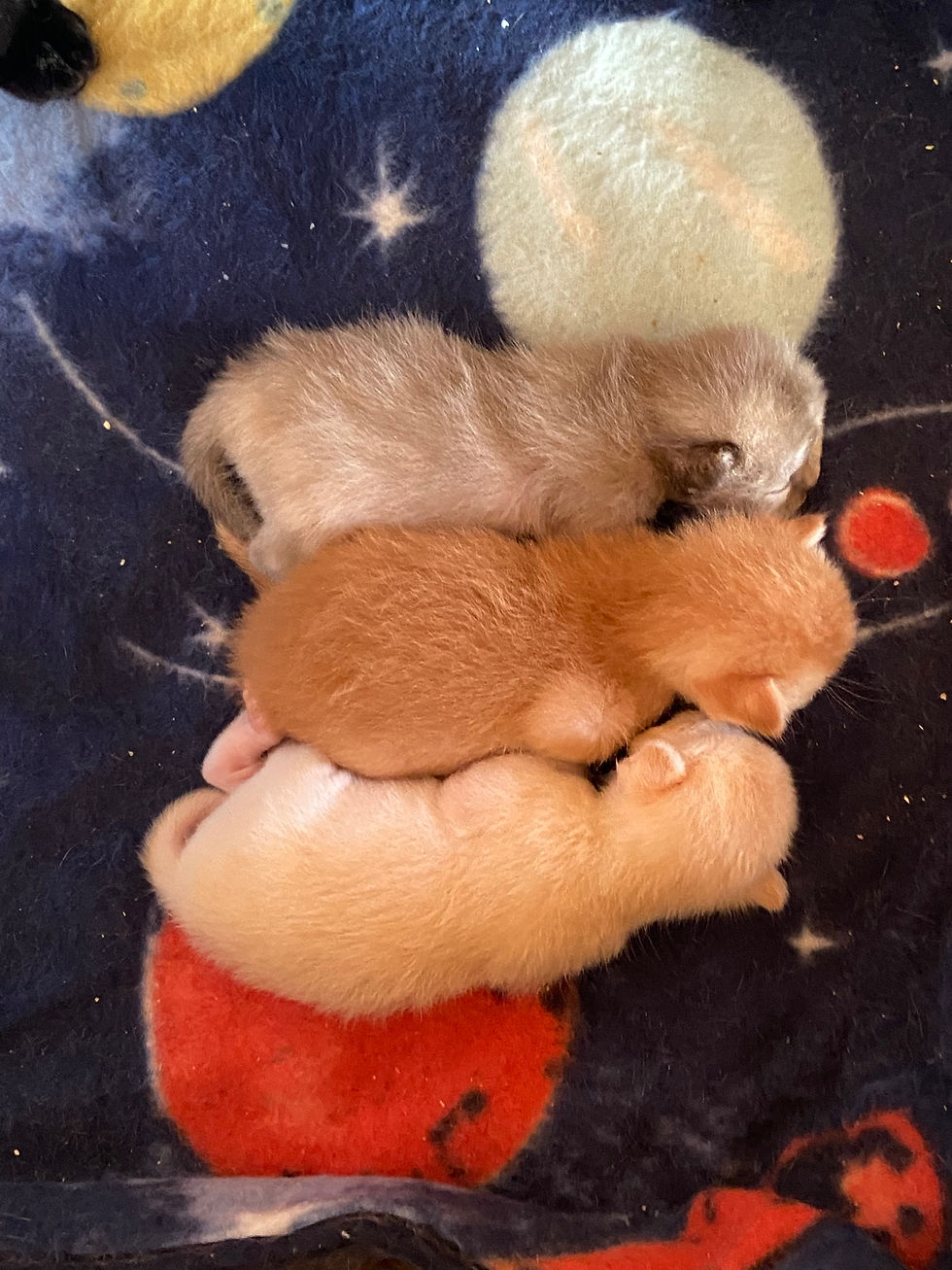Has Your Kitten Aspirated?
- miriamm00
- Oct 3
- 4 min read
What is Aspiration?
Newborn kittens sometimes have a rough start in life. Difficult births, prolonged labour, low birth weight, or being born breech can all put a kitten at risk of aspiration (breathing fluid or milk into the lungs). Aspiration at birth in a kitten is the accidental inhalation of fluid, such as amniotic fluid, milk, or other foreign substances, into the lungs. This can happen during a difficult birth, prolonged labor, or when a kitten is not positioned correctly for feeding. Inhaled material causes lung inflammation and irritation. The fluid aspirated during birth is often contaminated with bacteria from the vagina thus leading to infection. This can result in difficulty breathing, lethargy, fever, and can be fatal if not treated quickly.

Caring for newborn kittens when things don’t go smoothly
In addition, congenital issues such as cleft palate, a damaged trachea, or even hypoxic brain damage during birth can complicate those first crucial hours. Dystocia, hypoxia, and failure to thrive are significant pre-mortem risk factors for kittens under eight weeks (Dolan et al., 2020).
As a breeder, I’ve learned that quick action, gentle support, and careful monitoring can make the difference for these fragile babies.

Getting Them Breathing
When a kitten is born, I immediately dry them off with tissues — vigorously but carefully — to stimulate breathing. Most kittens should begin breathing and then feed within the first hour. “Drying and rubbing the neonate to stimulate respiration are first-line resuscitation measures in dogs and cats.” (RECOVER Initiative, 2025).
I don’t use suction devices or anything invasive to open the airways (this is NOT recommended in human babies based on current evidence). On the rare occasion a kitten is struggling, I’ll place a tissue over its mouth and gently puff in very tiny breaths (2-3 mls volume only), just enough to feel a chest rise. This can help kickstart the lungs.
IMPORTANT –before you do your ABC (airway, breathing, circulation) always check the kitten for congenital abnormalities before launching into a resuscitation – check the pelvic area around the spine for spina bifida and check the top of the head -it will save you a lot of grief later.
Monitoring Weight and Feeding
Weight monitoring is absolutely essential. I weigh kittens twice a day. Low birth weight and insufficient growth during the first 48 hours are strongly associated with increased neonatal mortality in kittens (Mugnier et al., 2023). Fading kitten syndrome may result from hypothermia, aspiration, or infection, and early intervention is critical for survival. (Münnich & Kuchenmeister, 2022). If a kitten hasn’t gained weight within 24 hours, I’ll firstly check for a cleft palate and if theyre clear then start topping up feeds and (in consultation with my vet) consider adding an antibiotic.
Feeding Approach:
First choice: syringe feeding with a Miracle Nipple (expensive, but the best investment I’ve made — easily found on Amazon).
If that fails: I’ll tube feed using a 3f tube and kitten-safe milk.
Here in New Zealand, I use Vitapet Pet Milk from the supermarket. Many very experienced breeders here recommend it, and I’ve had great results. Wherever you are, check with local breeders and your vet for the best milk replacer available in your area.
How Much to Feed?
A general guideline I follow:
Start: 2 mls every 3 hours.
If weight is dropping, the volume is too low.
By 80 grams, kittens should be on about 3 mls every 3 hours.
After 2–3 days, many kittens begin nursing a little from mum. At this stage, I often reduce top-ups to the daytime only, so they transition to full breastfeeding naturally.
Quick guide to tube feeding - it's not that hard so don't be scared.
Antibiotics (With Vet Guidance)
Antibiotics can sometimes be needed, but always consult with your vet for correct dosing. In my experience, Augmentin has been very hard to dose accurately for tiny kittens and seemed to contribute to flat-chested kittens in my Burmese lines. After switching to an alternative antibiotic (again, under veterinary guidance), I haven’t had a single flat-chested kitten — and all my kittens have thrived.
(I could talk all day about flat chested kittens – I’ll save that for another blog!)
Final Thoughts
Aspirated kittens can be saved with attentive care, patience, and vigilance. Dry them quickly, get them breathing, monitor weight religiously, and step in early with feeding support if they’re struggling. Always work alongside your vet when antibiotics or intensive care are needed.
Every kitten deserves the best chance at life — and while those early hours can be stressful, with the right approach you can often turn things around.
References
Dolan, E. D., Bannasch, D. L., Döring, M., & Kapatkin, A. S. (2020). Pre-mortem risk factors for mortality in kittens less than 8 weeks of age. Journal of Feline Medicine and Surgery, 22(11), 1045–1052. https://doi.org/10.1177/1098612X20937026
Mugnier, A., Mila, H., Guiraud, F., Brévaux, J., Lecarpentier, M., Grellet, A., & Chastant, S. (2023). Birth weight and early growth as risk factors for mortality in kittens. Animals, 13(3), 495. https://doi.org/10.3390/ani13030495
Mugnier, A., Mila, H., Brévaux, J., Grellet, A., & Chastant, S. (2024). Impact of compensatory growth on survival in newborn kittens. Frontiers in Veterinary Science, 11, 1408916. https://doi.org/10.3389/fvets.2024.1408916
Münnich, A., & Kuchenmeister, U. (2022). Causes, diagnosis and therapy of fading kitten syndrome: A review. Tierärztliche Praxis Kleintiere, 50(5), 271–280. https://doi.org/10.1055/a-1694-8010
RECOVER Initiative. (2025). RECOVER guideline for newborn resuscitation in dogs and cats. Journal of Veterinary Emergency and Critical Care, 35(S1), S1–S29. https://doi.org/10.1111/vec.13312



Comments